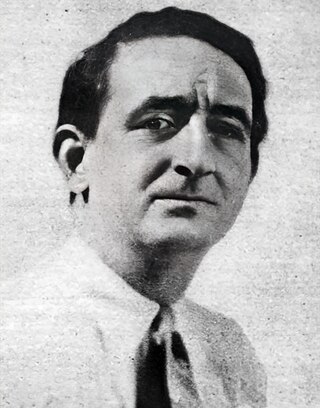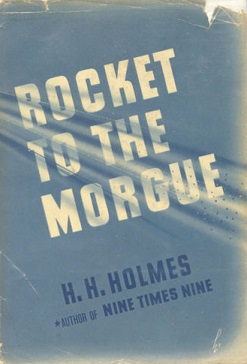John Dudley Ball Jr. was an American writer best known for mystery novels involving the African-American police detective Virgil Tibbs. Tibbs was introduced in the 1965 novel In the Heat of the Night, which won the Edgar Award for Best First Novel from the Mystery Writers of America and was made into an Oscar-winning film of the same name, starring Sidney Poitier and Rod Steiger.
Duell, Sloan and Pearce was a publishing company located in New York City. It was founded in 1939 by C. Halliwell Duell, Samuel Sloan and Charles A. Pearce. It initially published general fiction and non-fiction, but not westerns, light romances or children's books. It published works by many prominent authors, including Archibald MacLeish, John O'Hara, Erskine Caldwell Anaïs Nin, Conrad Aiken, Wallace Stegner, E. E. Cummings, Howard Fast, Benjamin Spock, Joseph Jay Deiss, and William Bradford Huie. In addition to their literary list, the firm published many works of military history, with a focus on aviation in the war years.

The Golden Age of Detective Fiction was an era of classic murder mystery novels of similar patterns and styles, predominantly in the 1920s and 1930s. The Golden Age proper is in practice usually taken to refer to a type of fiction which was predominant in the 1920s and 1930s but had been written since at least 1911 and is still being written today. In his history of the detective story, Bloody Murder: From the Detective Story to the Crime Novel, the author Julian Symons heads two chapters devoted to the Golden Age as "the Twenties" and "the Thirties". Symons notes that Philip Van Doren Stern's article, "The Case of the Corpse in the Blind Alley" (1941), "could serve ... as an obituary for the Golden Age." Authors Agatha Christie, Dorothy L. Sayers, Margery Allingham, and Ngaio Marsh have been collectively called the Queens of Crime.
Otto Penzler is an American editor of mystery fiction, and proprietor of The Mysterious Bookshop in New York City.
Dorothy B. Hughes was an American crime writer, literary critic, and historian. Hughes wrote fourteen crime and detective novels, primarily in the hardboiled and noir styles, and is best known for the novels In a Lonely Place (1947) and Ride the Pink Horse (1946).
Bloodhound is a dog breed.
Kenneth Martin Edwards is a British crime novelist, whose work has won multiple awards including lifetime achievement awards for his fiction, non-fiction, short fiction, and scholarship in the UK and the United States. In addition to translations into various European languages, his books have been translated into Japanese, Chinese, Korean, and Taiwanese. As a crime fiction critic and historian, and also in his career as a solicitor, he has written non-fiction books and many articles. He is the current President of the Detection Club and in 2020 was awarded the Crime Writers' Association's Diamond Dagger, the highest honour in British crime writing, in recognition of the "sustained excellence" of his work in the genre.
Marie Freid Rodell was a literary agent and author who managed the publications of much of environmentalist Rachel Carson's writings, as well as the first book by civil rights activist Martin Luther King Jr.
Elisabeth Sanxay Holding (1889–1955) was an American novelist and short story writer. She primarily authored fiction in the hardboiled subgenre of detective novels.

Charles Fulton Oursler Sr. was an American journalist, playwright, editor and writer. Writing as Anthony Abbot, he was an author of mysteries and detective fiction. His son was the journalist and author Will Oursler (1913–1985).

Leslie S. Klinger is an American attorney and writer. He is a noted literary editor and annotator of classic genre fiction, including the Sherlock Holmes stories and the novels Dracula, Frankenstein, and Strange Case of Dr. Jekyll and Mr. Hyde as well as Neil Gaiman's The Sandman comics, Alan Moore's and Dave Gibbons's graphic novel Watchmen, the stories of H.P. Lovecraft, and Neil Gaiman's American Gods.

Rocket to the Morgue is a 1942 American locked room mystery novel by Anthony Boucher.
Virginia Rudd Lanier was an American mystery fiction writer, author of a series featuring bloodhound trainer Jo Beth Sidden.
Lenore Glen Offord was an American writer and reviewer of detective fiction.
Manning Long, was an American writer of detective fiction, known for the Liz Parrott mysteries.

Dread Journey is a 1945 mystery thriller novel by the American writer Dorothy B. Hughes, noted for her hardboiled style. It was first published by Duell, Sloan and Pearce.

The Bamboo Blonde is a 1941 American mystery thriller novel by the American writer Dorothy B. Hughes. It was a sequel to the author's 1940 debut novel The So Blue Marble, with the setting shifted from New York City to the West Coast. It was written and set shortly before America's entry into World War II. It was first published by Duell, Sloan and Pearce.

The Blackbirder is a 1943 mystery thriller novel by the American writer Dorothy B. Hughes. It was first published by Duell, Sloan and Pearce. It was one of several novels by Hughes set in the American Southwest.

The Davidian Report is a 1952 spy thriller novel by the American writer Dorothy B. Hughes. It was first published by Duell, Sloan and Pearce. While many of her previous works had been set during World War II, this shifted the focus to the early Cold War. It was her penultimate novel, followed after an eleven-year gap by The Expendable Man in 1963.

The Delicate Ape is a 1944 mystery thriller novel by the American author Dorothy B. Hughes. It was first published by Duell, Sloan and Pearce. Although written while World War II was still being fought, Hughes sets her novel in a futuristic era twelve years after the end of the world war. It revolves around an upcoming peace conference in New York where the major powers debate withdrawing the occupying forces following the defeat of Nazi Germany a decade earlier.








